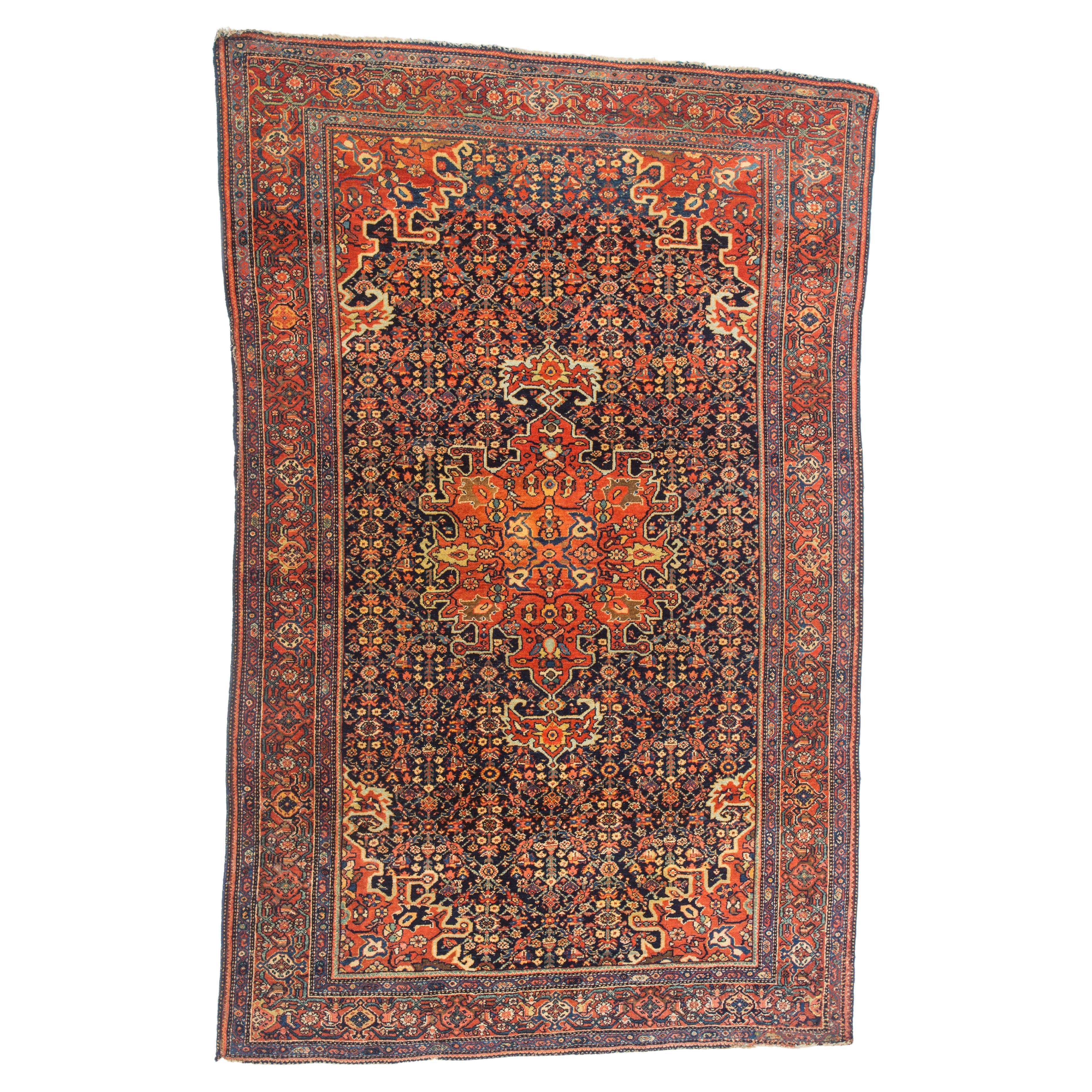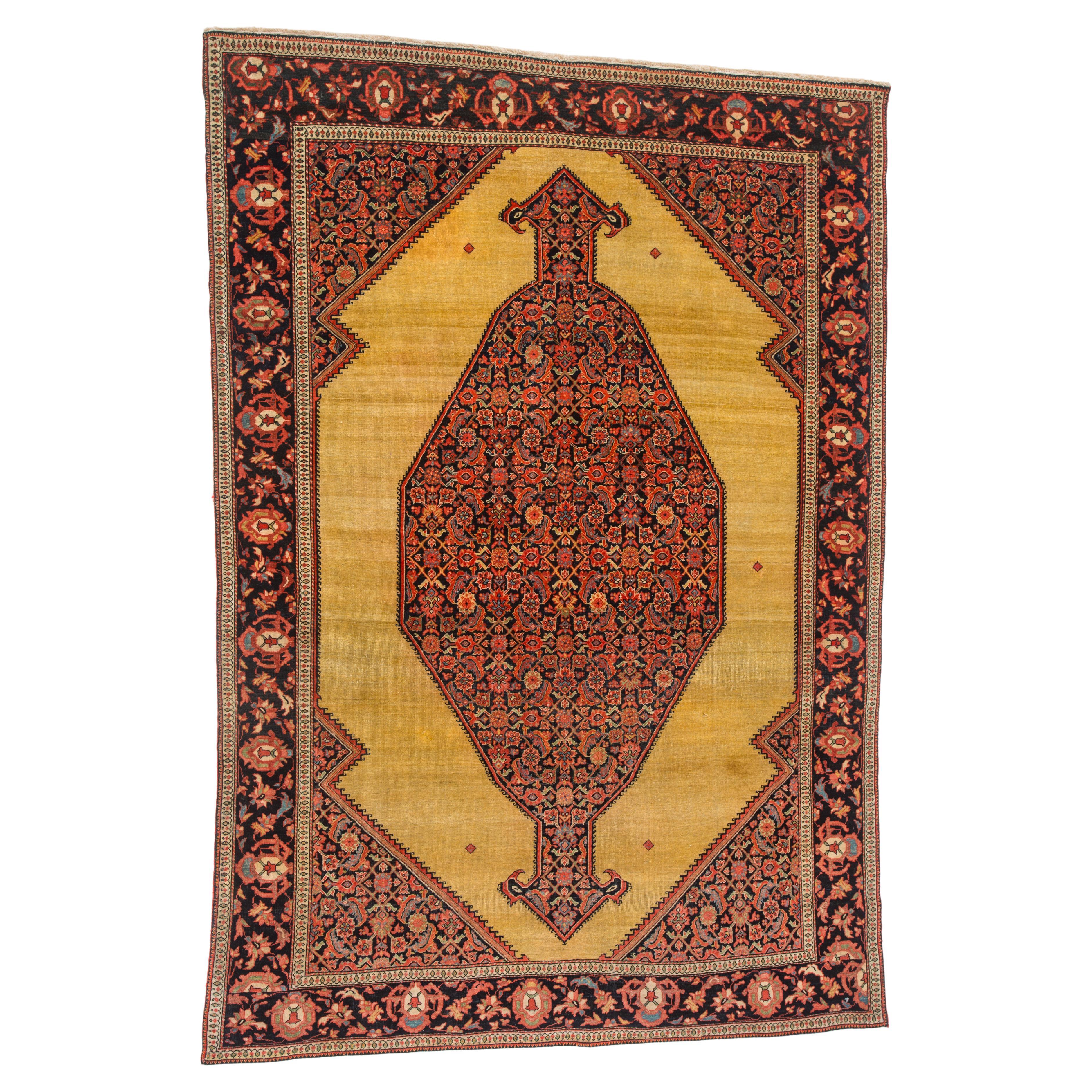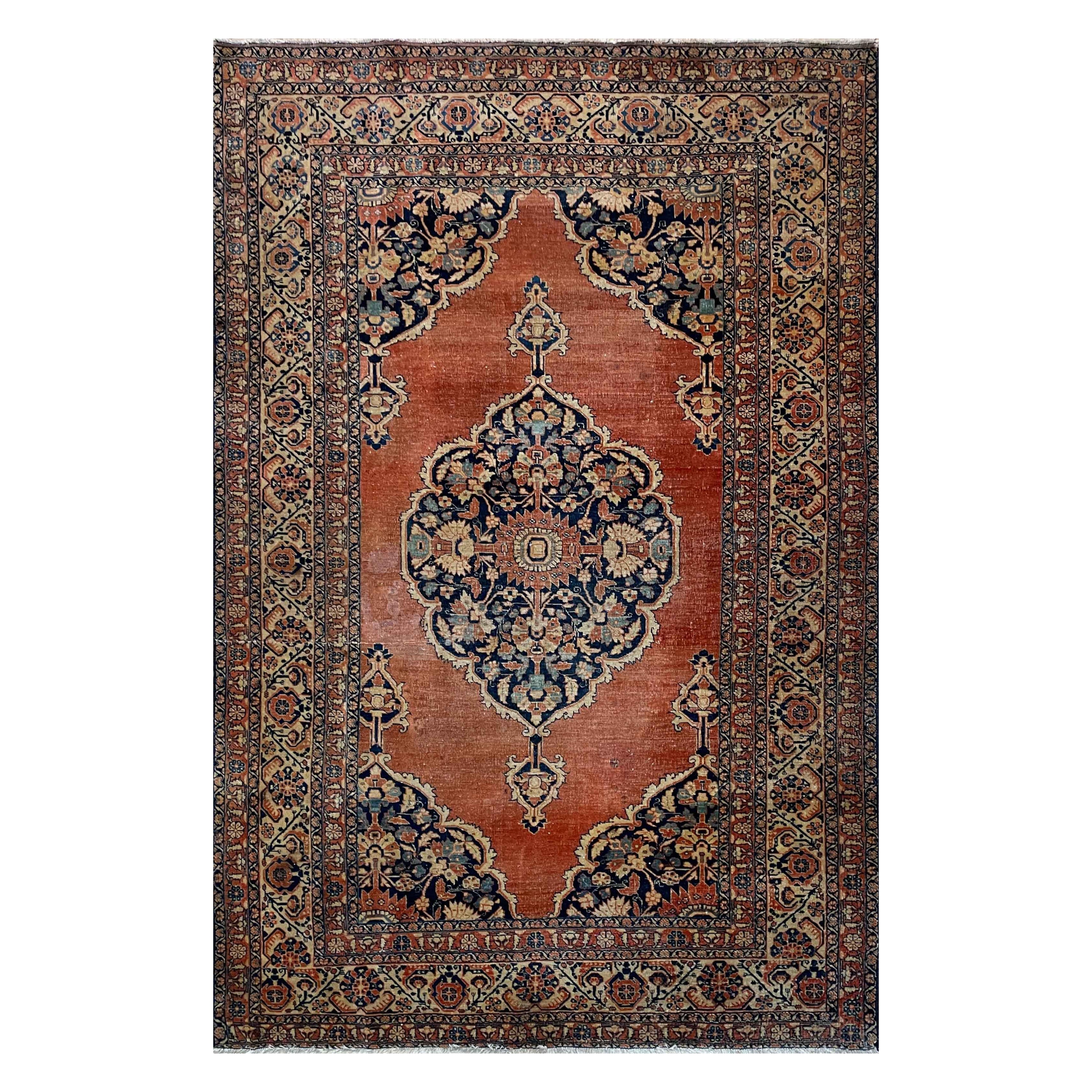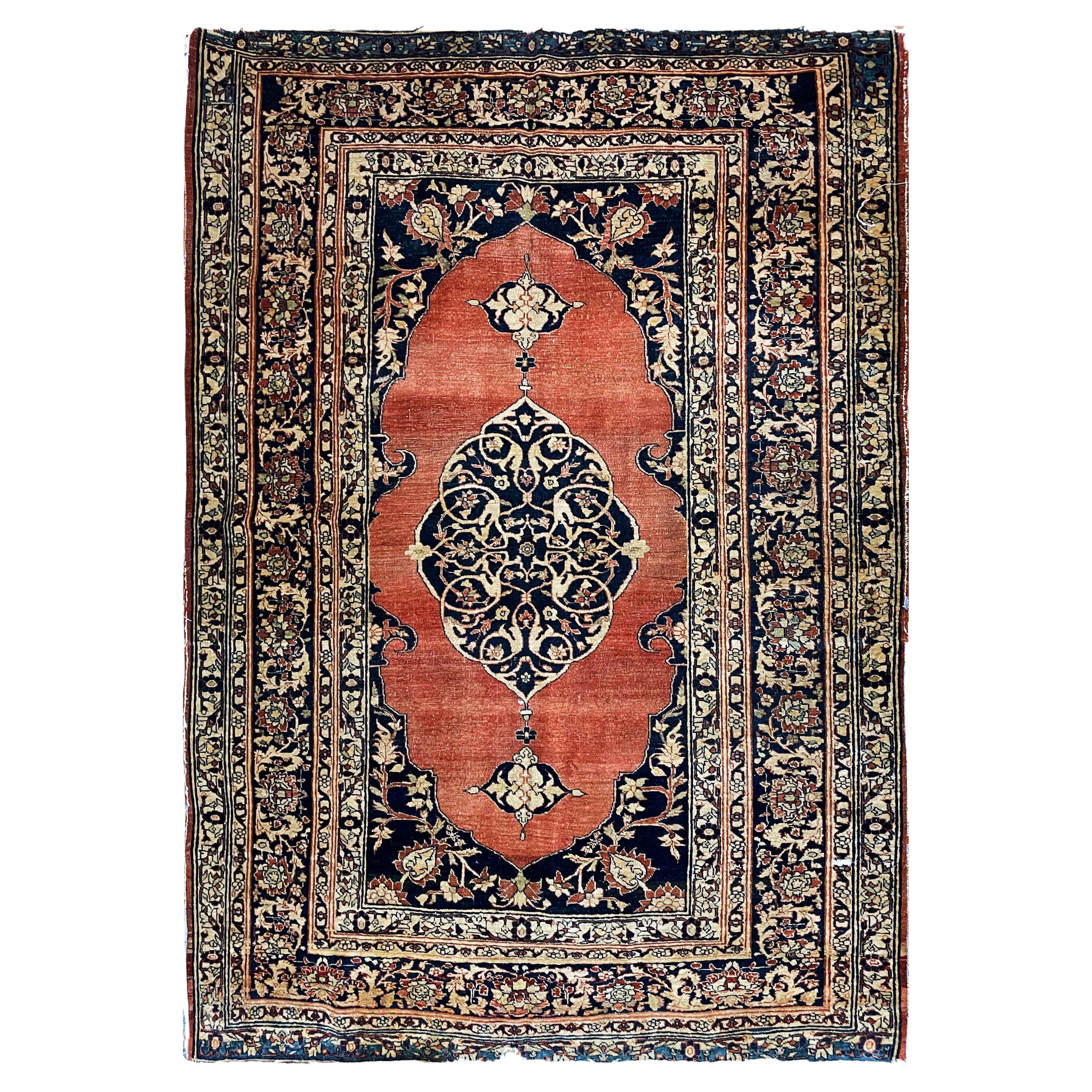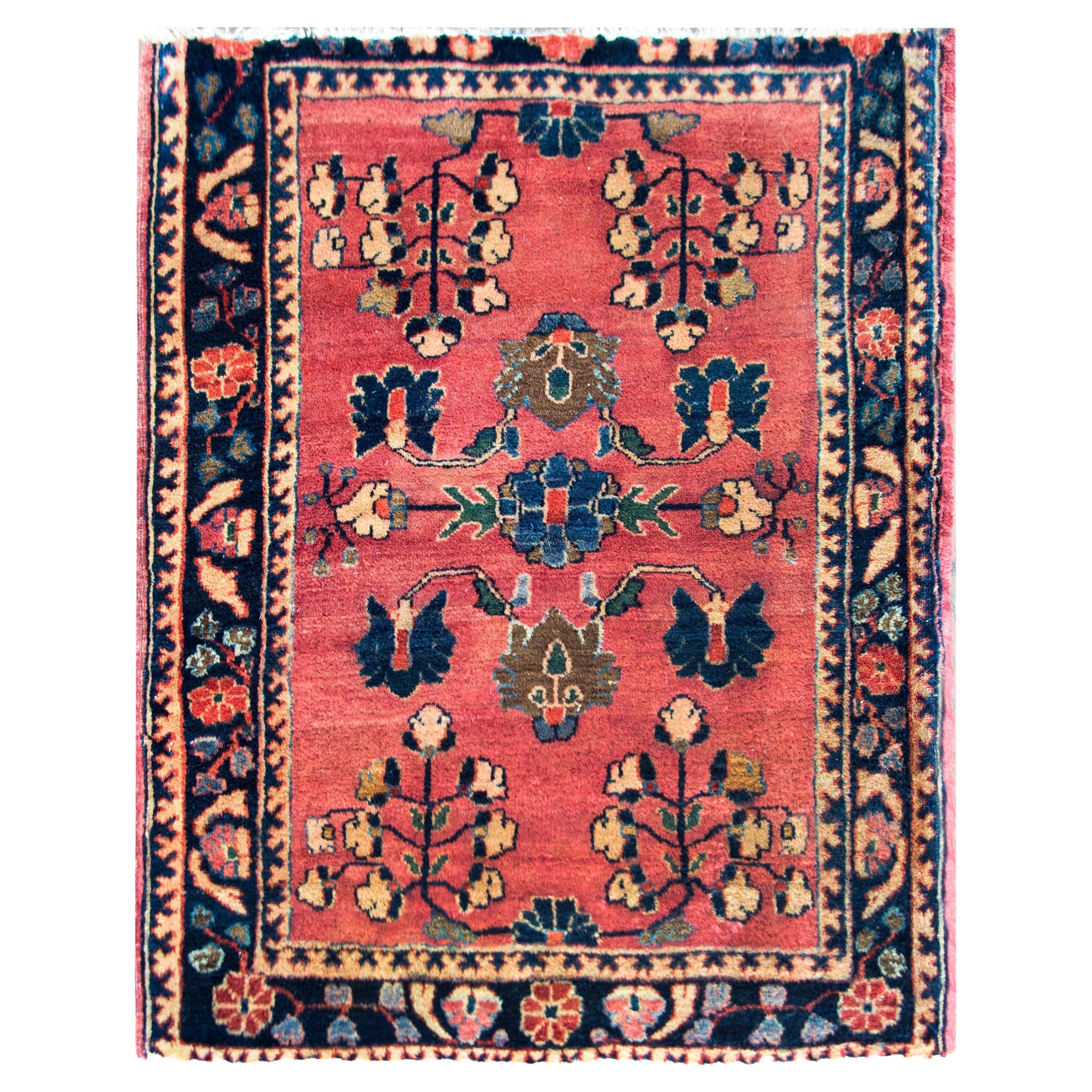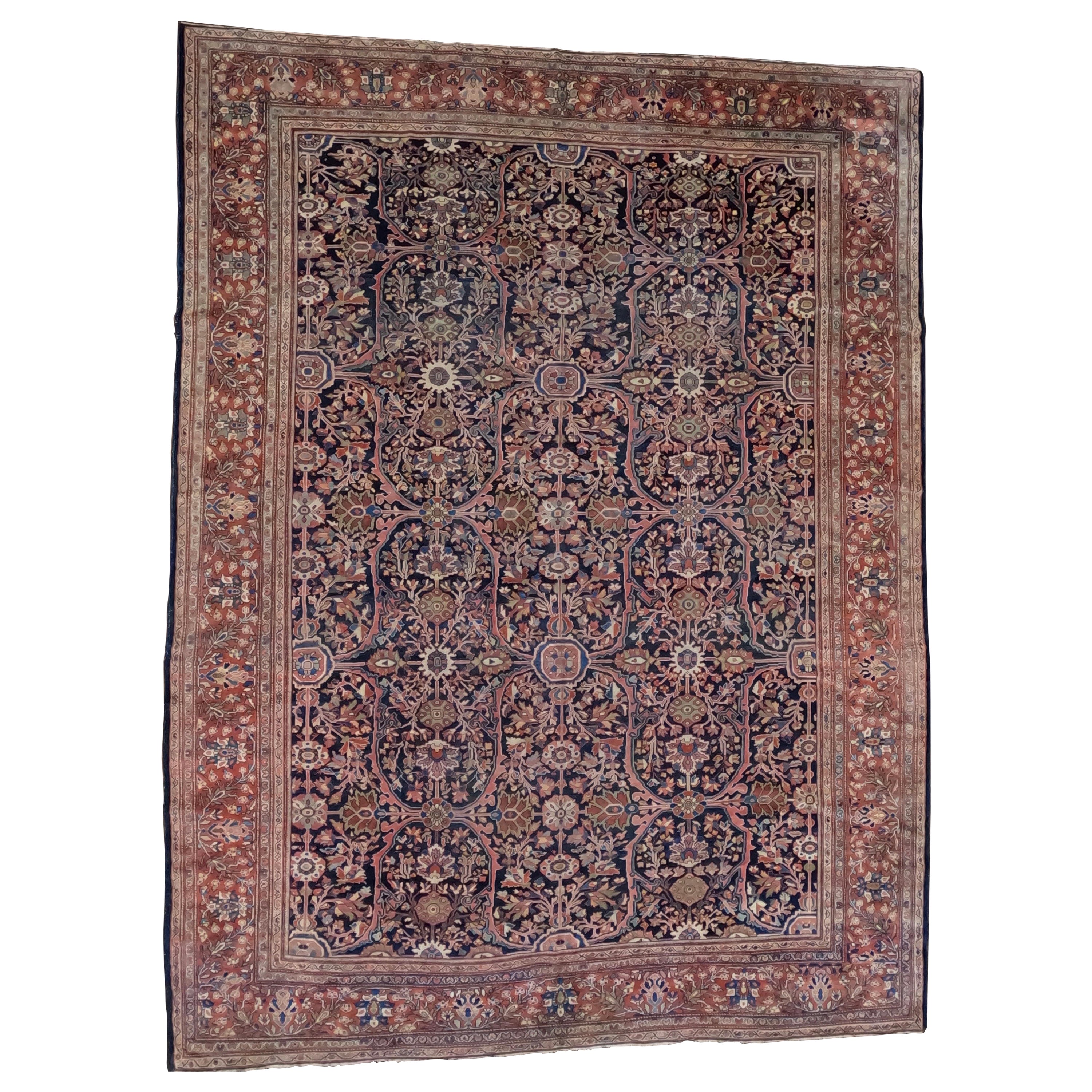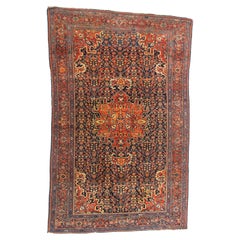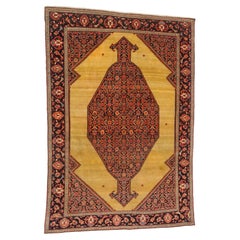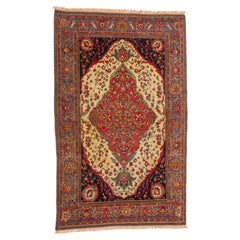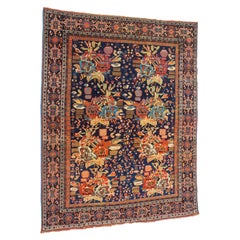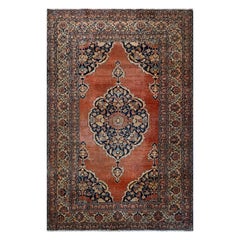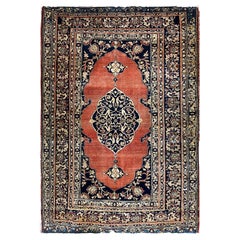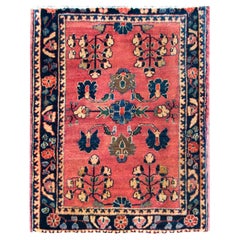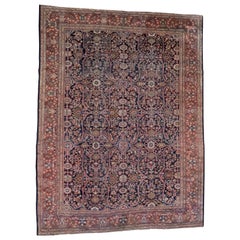Items Similar to Aristocratic Ferahan Sarouk 1890 Antique Short Term Reduction
Want more images or videos?
Request additional images or videos from the seller
1 of 11
Aristocratic Ferahan Sarouk 1890 Antique Short Term Reduction
$7,920
$11,75032% Off
£5,980.46
£8,872.5232% Off
€6,891.82
€10,224.6132% Off
CA$11,178.49
CA$16,584.2432% Off
A$12,324.03
A$18,283.7532% Off
CHF 6,447.53
CHF 9,565.4732% Off
MX$151,192.91
MX$224,307.6632% Off
NOK 81,161.67
NOK 120,410.3032% Off
SEK 75,898.99
SEK 112,602.6732% Off
DKK 51,468.29
DKK 76,357.6332% Off
About the Item
ARISTOCRATIC Ferahan Sarouk 1890
Measures: 6 ft 8 inches x 4 foot 4 inches
Ladies, if you seek a gift for your much loved man, to make him feel like a Prince, consider this little piece of aristocracy.
Ferahan Sarouk carpets produced around the wider Arak (formerly Sultanabad) area from about 1850-1900 earned a deserved reputation as amongst the most desirable and imaginative finely woven carpets in Persia. As these things go, they morphed in style around 1900- 1920 into the differently woven Mahajirhan Sarouk fashion (quality examples of which are also in demand, but very different ) and then disappeared entirely.
Their desirability rests not only on fine weaving, and excellent wool. Many of the better examples were commissioned by aristocrats or wealthy merchants who encouraged creativity, one source of their excellence. This is probably the genesis of this example .
Beyond this lay a more fundamental and seemingly contradictory set of motivations by the weavers. At one and the same time they sought to emulate the great court carpets in finesse and design, and yet-- they applied rustic or village, and even tribal elements and nuances to their designs. The result was a cavalcade of creativity.
So, a village-based genre came into being which produced primarily an approx. 6x4 rug size format, and provided, if more rarely, larger formats, which command increasingly high prices, due to their rarity, visual excitement and grandeur.
The artistic achievement of this “school” had to do with marrying elegance and a degree of formalism with whimsy, and design innovation. They offer a charm and a certain magic beyond that of court and most city carpets ..
As in any area or era, there is a quality spectrum ranging from mediocre to highly superior. Superiority is judged of course as to weave and wool quality. It is rather unusual, though, to encounter pieces made before 1890 - which are bona fide Ferahan Sarouks- with poor wool or weaving: standards were upheld during this period, and natural dyes employed universally.
Thus, as an investment collectible to adorn the home we believe the ultimate criterion is aesthetics, this being an art form, after all.
Ferahan Sarouks have been a special area of interest for us over the decades both from artistic and investment perspectives.
Allowing for personal taste, our suggestions are few and simple. A Ferahan Sarouk ought to display a wide colour palette, fine drawing and delicate, sometimes “intense “detail. The finest pieces also display balance in the use of space.
We have seen many finely woven pieces which in our view are garish and lack one of the two key artistic elements intrinsic to the better examples of this genre – elegance. Sometimes they are overly cluttered; the drawing artistry is muddled or lost. In other cases odd and ineffective design devices are used, detracting from or interfering with an otherwise good design. The era of the Ferahan Sarouk was rife with experiment, not all of them successful.
The other important attribute, when it can be found, is original artistic creativity, even serendipity, -- or effective design innovation within the compass of this rug type and the unique standards of its prime period.
On average, we examine between 30-40 antique Ferahan Sarouks to achieve one acquisition, for the benefit of our clients.
This striking 130-year-old piece projects an aristocratic bearing and recalls the grand court carpet tradition, in miniature. And with light touches of informality which were simply not permitted in court carpets . These had charm and individuality .
Its wide colour palette is very well applied and the drawing of the central medallion especially fine. Note please how the two extended “branches “which extend from the lower half of the medallion progress through a range of colours and refer to the drawing and colours of the outer field. Indeed, this sort of drawing is fine and original artistry as it extends imaginatively from the essentially classical, formal medallion.
This is the inspired level by the weaver/designer we look for in a collectible Ferahan Sarouk. This is a solid investment piece . Ferahan Sarouk weaving ended over a century ago , and pieces of this calibre have never been repeated, though the term Ferehan Sarouk is sometimes thrown about quite recklessly in the market place . And so called modern " revival pieces" bearing the name, have no investment value whatsoever .
What is also impressive is the subtle but highly effective use of space around the edges and sides of the reserve – this provides relief from the energy within the piece and balances the composition.
The rug is very finely woven in excellent wool, soft and in virtually as new condition, remarkably, for its age.
Another attribute, quite rare is its soft deep near black background which amplifies its colours, and gives the overall work of art a radiating sense of strength . Such backgrounds are rarely seen .
As a high decorative item it would beautifully adorn any number of spaces in a contemporary home or apartment.
We have acquired this singular rug as part of a substantial trade and are able to provide it at below comparative market value. Given its remarkable condition, exceptional wool, full pile, and design elegance a fair market value at " low retail price" is $14,000.
- Dimensions:Width: 52 in (132.08 cm)Length: 80 in (203.2 cm)
- Materials and Techniques:Wool,Woven
- Place of Origin:
- Period:
- Date of Manufacture:1890
- Condition:This rug is in an uncommonly good and pristine condition with full pile , remarkable for its age .
- Seller Location:WYNNUM, AU
- Reference Number:Seller: FAC4011 1111stDibs: LU7409231349412
About the Seller
No Reviews Yet
Vetted Professional Seller
Every seller passes strict standards for authenticity and reliability
1stDibs seller since 2022
- ShippingRetrieving quote...Shipping from: WYNNUM, Australia
- Return Policy
Authenticity Guarantee
In the unlikely event there’s an issue with an item’s authenticity, contact us within 1 year for a full refund. DetailsMoney-Back Guarantee
If your item is not as described, is damaged in transit, or does not arrive, contact us within 7 days for a full refund. Details24-Hour Cancellation
You have a 24-hour grace period in which to reconsider your purchase, with no questions asked.Vetted Professional Sellers
Our world-class sellers must adhere to strict standards for service and quality, maintaining the integrity of our listings.Price-Match Guarantee
If you find that a seller listed the same item for a lower price elsewhere, we’ll match it.Trusted Global Delivery
Our best-in-class carrier network provides specialized shipping options worldwide, including custom delivery.More From This Seller
View AllClassic Antique 1870 Ferahan Sarouk -Intense Design Virtues
Located in WYNNUM, QLD
From an Australian Collector
Ferahan Sarouk carpets produced around the wider Arak (formerly Sultanabad) area from about 1850-1910 earned a deserved re...
Category
Antique 1870s Persian Persian Rugs
Materials
Wool
$6,320 Sale Price
36% Off
High Collectible 19th Century Ferahan Sarouk, Princely, at Short Term Reduction
Located in WYNNUM, QLD
Ferahan Sarouk Museum Quality
MUSEUM QUALITY Ferahan Sarouk, third quarter 19th century
6.6 x 4.5 feet
From a USA collector
Ferahan Sarouk carpets produced around the wider Arak (formerly Sultanabad) area from about 1850-1910 earned a deserved reputation as amongst the most desirable and imaginative finely woven carpets in Persia. As these things go, they morphed in style around 1910- 1920 into the differently woven Mahajirhan Sarouk fashion (quality examples of which are also in demand) and then disappeared entirely.
Their desirability rests not only on fine weaving, and excellent wool. Many of the better examples were commissioned by aristocrats or wealthy merchants who encouraged creativity, in an actively competitive way; rugs during this period, as before, were direct illustrations of an individual’s wealth, power and prestige.
Beyond this lay a more fundamental and seemingly contradictory set of motivations by the weavers. At one and the same time they sought to emulate the great court carpets in finesse and design. And yet-- they applied rustic or village, and even tribal elements and nuances to their designs. The result was a cavalcade of creativity.
So, a village-based genre came into being which produced primarily an approx. 6x4 rug size format, and also provided, if more rarely, larger formats, which command increasingly high prices, due to their rarity, visual excitement and grandeur.
The artistic achievement of this “school” had to do with marrying elegance and a degree of formalism with whimsy, and design innovation. They offer a charm and a certain magic beyond that of court and most city carpets.
As in any area or era, there is a quality spectrum ranging from mediocre to highly superior. Superiority is judged of course as to weave and wool quality. It is rather unusual, though, to encounter pieces made before 1890 -which are bona fide Ferahan Sarouks- with poor wool or weaving: standards were upheld during this period, and natural dyes were widely employed, particularly in the wider Arak (then Sultanabad) region.
Thus, as an investment collectible to adorn the home we believe the ultimate criterion is aesthetics, this being an art form, after all.
Ferahan Sarouks have been a special area of interest for us over the decades both from artistic and investment perspectives.
Allowing for personal taste, our suggestions are few and simple. A Ferahan Sarouk ought to display a wide colour palette, fine drawing and delicate, sometimes “intense “ detail. The finest pieces also display an elevated sense of balance in the use of space.
We have seen many finely woven pieces which in our view are garish and lack one of the two key artistic elements intrinsic to the better examples of this genre – elegance. Sometimes they are overly cluttered; the drawing artistry is muddled or lost. In other cases odd and ineffective design devices are used, detracting from or interfering with an otherwise good design. The era of the Ferahan Sarouk was rife with experiments, not all of them successful.
The other important attribute, when it can be found, is original artistic creativity, even serendipity, -- or effective design innovation within the compass of this rug type and the unique standards of its prime period.
On average, we examine between 30-40 antique Ferahan Sarouks to achieve one acquisition, for the benefit of our clients.
This highly collectible more than 150-year-old carpet is an apex achievement of superior artistry and innovation. As an exemplar of its genre, it can be reasonably described as Museum quality, a term we do not often employ.
Please observe the stunning precision of the inner guard and its pinpoint sharp hooks. The elongation of the central medallion is one of its subtle but powerful innovations in form. The nod to asymmetry – which displays a refined sense of humour - is seen in the use of the small diamond figures, as one is deliberately missing from the right hand side: a wry nod to asymmetry, in an otherwise perfectly symmetrical creation.
The ultimate achievement here is in the fineness of the weaving itself, on close inspection. The herati pattern in the medallion and corners achieves an etched-on quality, a very uncommon level of attention to detail and perfectionism: clearly the work of a master. This artistic sense extends to the outer ground which is a superb example of the most subtle abrash, one of the most refined we have had the honor of viewing. The unusual beige/brown tones in the field were probably achieved by adding onion skins to the die vat. These extremely fine gradations of colour are rarely seen.(NB the colour photographs create a slightly misleading- overly yellow burnish to the field colour in spite of expert photographic efforts ) .
The deliberate choice of an ink black use of indigo provides a powerful frame (border) for this piece of art, which note in the lower right-hand corner is lifted slightly through abrash to a deep blue – to highlight the design and use of emerald green in the rosettes. The green shades lighten as the border ascends harmonizing with the tones in the central medallion.
The floating flow of flowers in the border is beautifully executed, with up to seven colours in a single figure.
No doubt a piece commissioned by an aristocrat around 1870, it is – remarkably- in virtually perfect condition. It appears to have had very minimal footwear, and great care; a piece which was proudly displayed from time to time and appreciated. Its density and strong foundation would however allow regular use within a home, and in a spacious contemporary home or office could make a wall hanging of striking impact.
This remarkable one of a kind piece is on short term reduction to coincide with our launch on 1st Dibs . Fair market value is approximately $22,000 .
Fine art as investment ? The WSJ made the following comments this year :
The vigor of the art market may seem counterintuitive, but it makes sense in the current environment,” economist Tyler Cowen recently wrote in The Washington Post. “First, many of the wealthy have been buying additional homes and wish to furnish them with art. Second, the recent run-up in inflation rates around the world has intensified the search for hedges.”
While the aforementioned artworks fall into traditional categories, some less-prominent forms of fine art also represent ideal investment opportunities, especially because they offer more attractive—i.e., significantly less costly—entry points for new collectors. Take high-collectible and connoisseur-caliber antique Oriental rugs, for example. The best 19th-century examples often sell privately between five figures and low six figures.
Today, that obscurity is fading. According to Ben Evans, the editor of Hali Magazine—a publication dedicated to the international rug and textile market—there are two primary factors to explain why antique rugs are beginning to enjoy their moment in the spotlight. “Cultural curiosity and collecting...
Category
Antique 1880s Persian Persian Rugs
Materials
Wool
Impeccable Artistic Antique Ferahan Sarouk, 1880
Located in WYNNUM, QLD
Acquired from a Swedish collector
Ferahan Sarouk carpets produced around the wider Arak (city) area from about 1850-1900 earned a deserved reputation as amongst the most desirable and imaginative finely woven carpets in Persia. As these things go, they morphed in style around 1910- 1920 into the differently woven Mahajirhan Sarouk fashion (quality examples of which are also in demand) and then disappeared entirely.
Their desirability rests not only on fine weaving, and excellent wool. Many of the better examples were commissioned by aristocrats or wealthy merchants who encouraged new approaches and creativity, one source of their excellence.
Beyond this lay a more fundamental and seemingly contradictory set of motivations by the weavers. At one and the same time they sought to emulate the great court carpets in finesse and design, and yet-- they applied rustic or village, and even tribal elements and nuances to their designs. The result was a cavalcade of creativity.
So, a village-based genre came into being which produced primarily an approx. 6x4 rug size format, and also provided, if more rarely, larger formats, which command increasingly high prices, due to their rarity, visual excitement and grandeur.
The artistic achievement of this “school” had to do with marrying elegance and a degree of formalism with whimsy, and design innovation. They offer a charm and a certain magic beyond that of court and most city carpets.
As in any area or era, there is a quality spectrum ranging from mediocre to highly superior. Superiority is judged of course as to weave and wool quality. It is rather unusual, though, to encounter pieces made before 1890 -which are bona fide Ferahan Sarouks- with poor wool or weaving: standards were upheld during this period, and natural dyes employed universally.
Thus, as an investment collectible to adorn the home we believe the ultimate criterion is aesthetics, this being an art form, after all.
Ferahan Sarouks have been a special area of interest for us over the decades both from artistic and investment perspectives.
Allowing for personal taste, our suggestions are few and simple. A Ferahan Sarouk ought to display a wide colour palette, fine and creative drawing and delicate, sometimes “intense “detail. The finest pieces also display balance in the use of space.
We have seen many finely woven pieces which in our view are garish and lack one of the two key artistic elements intrinsic to the better examples of this genre – elegance. Sometimes they are overly cluttered; the drawing artistry is muddled or lost. In other cases odd and ineffective design devices are used, detracting from or interfering with an otherwise good design. The era of the Ferahan Sarouk was rife with experiment, not all of them successful.
The other important attribute, when it can be found, is original artistic creativity, even serendipity, -- or effective design innovation within the compass of this rug type and the unique standards of its prime period.
On average, we examine between 20-30 antique Ferahan Sarouks...
Category
Antique Late 19th Century Persian Persian Rugs
Materials
Wool
$7,900 / item
Antique 19th century Afshar , Perfect condition , Plush
Located in WYNNUM, QLD
From a Boston Collector.
Remarkably Creative.
This is another of our small stock of Afshar collectibles which astonish as to their artistic form. This example was recently acquired from a Boston collector’s estate. The wool, very soft, is of excellent quality and the weave very fine, the rug in superior condition.
Boston Antique carpet expert Michael Grogan declared it as one of the very finest and most original Afshar rugs he had ever seen.
This piece was recently used along with two others in a lecture series which pondered the question of likely influence of tribal (and arguably other Persian e,g, Montasham Kashan) rugs on the development of Western 20th century painting.
The abrupt break with traditional forms by a gifted female weaver in a remote location and in the throes of a nomadic life, considering her circumstances, is awe inspiring.
The wide and in cases unusual colors deployed (note the dark browns probably achieved with walnut shells in the dye vat...
Category
Antique 1890s Persian Persian Rugs
Materials
Wool
Late 3rd Quarter 19th Century Antique Ferahan Sarouk, Glorious Flowers
Located in WYNNUM, QLD
Ferahan Sarouk, 1870 :GLORIOUS FLOWERS
.
From a German collector
Ferahan Sarouk carpets produced around the wider Arak (formerly Sultanabad) are...
Category
Antique 1870s Persian Persian Rugs
Materials
Wool
Antique 1880 Shirvan Caucasian investment carpet . rare, excellent condition
Located in WYNNUM, QLD
From a Philadelphia Collector
This is a very robust member of the esteemed, and increasingly rare 19th century Afstaka “family”. It is slightly longer and wider than many exam...
Category
Antique 1870s Azerbaijani Caucasian Rugs
Materials
Wool
You May Also Like
Antique Persian Feraghan Sarouk, The Most decorative, As Is
Located in Evanston, IL
Introducing the exquisite Sarouk Feraghan, a timeless rug dating back to the late 1880s and remarkably preserved in excellent condition.
Woven in and around the picturesque region o...
Category
Antique Late 19th Century Persian Sarouk Farahan Persian Rugs
Materials
Wool
Antique Persian Feraghan Sarouk, The Most decorative, As Is
Located in Evanston, IL
Introducing the exquisite Sarouk Feraghan, a timeless rug dating back to the late 1880s and remarkably preserved in excellent condition.
Woven in and around the picturesque region o...
Category
Antique Late 19th Century Persian Sarouk Farahan Persian Rugs
Materials
Wool
Early 20th Century Persian Sarouk
Located in Chicago, IL
A sweet early 20th century Persian Sarouk rug with a simple but beautiful mirrored floral pattern woven in indigo, brown, green, ream, and pink, set against a pink background, and su...
Category
Vintage 1920s Persian Sarouk Farahan Persian Rugs
Materials
Wool
Antique Persian Sarouk Farahan Circa 1900
Located in Morton Grove, IL
Tightly hand knotted, this carpet is made in the town of Farahan in west Persia. Farahan rugs are made with hard wool and clipped very flat. The restrained style of decoration is alm...
Category
Antique Early 1900s Persian Sarouk Farahan Persian Rugs
Materials
Wool
Wonderful Early 20th Century Sarouk Moharramat
Located in Chicago, IL
A wonderful early 20th century Persian Sarouk Moharramat rug with a bold all-over lattice floral pattern woven in crimson, pink, light indigo, and gold, on a rich dark indigo backgro...
Category
Vintage 1920s Persian Sarouk Farahan Persian Rugs
Materials
Wool
Antique Fine Farahan Sarouk Rug
Located in Katonah, NY
:: Small Farahan Sarouk Ivory Circa 1900. Super unusual main design elements of shadowed samovar design with a repeating herati motif of pomegrana...
Category
Antique Early 1900s Persian Sarouk Farahan Persian Rugs
Materials
Wool, Cotton
More Ways To Browse
Noir Coffee Table
Oval Tureen
Pair Chaises Lounges
Peacock Blue Glass
Pedestal Tea Table
Sculptural Lounge Chair And Ottoman
Sculptural Wood Coffee Table
Set Of 2 Club Chairs
Used Bernhardt Furniture
Vintage Glass Hallmarks
Vintage Jug
19th Century Dutch Silver
Angelo Mangiarotti Round Dining Table
Antique Bronze Marble Side Table
Antique Desk Sweden
Antique Louis Xv Walnut Side Table
Antique Swedish Painted Dining Tables
Antique Table Pedestal Hand Carved
